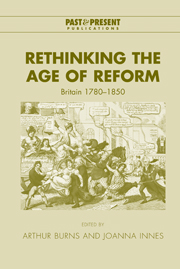Book contents
- Frontmatter
- Contents
- Notes on contributors
- Preface
- List of abbreviations
- 1 Introduction
- 2 ‘Reform’ in English public life: the fortunes of a word
- 3 Parliament, the state, and ‘Old Corruption’: conceptualizing reform, c. 1790–1832
- 4 ‘Old wine in new bottles’: the concept and practice of law reform, c. 1780–1830
- 5 English ‘church reform’ revisited, 1780–1840
- 6 Medicine in the age of reform
- 7 British antislavery reassessed
- 8 ‘The age of physiological reformers’: rethinking gender and domesticity in the age of reform
- 9 Reforming the aristocracy: opera and elite culture, 1780–1860
- 10 Reform on the London stage
- 11 Reforming culture: national art institutions in the age of reform
- 12 Irish reform between the 1798 Rebellion and the Great Famine
- 13 Empire and parliamentary reform: the 1832 Reform Act revisited
- 14 Reforms, movements for reform, and possibilities of reform: comparing Britain and continental Europe
- Index
- Past and Present Publications
11 - Reforming culture: national art institutions in the age of reform
Published online by Cambridge University Press: 15 December 2009
- Frontmatter
- Contents
- Notes on contributors
- Preface
- List of abbreviations
- 1 Introduction
- 2 ‘Reform’ in English public life: the fortunes of a word
- 3 Parliament, the state, and ‘Old Corruption’: conceptualizing reform, c. 1790–1832
- 4 ‘Old wine in new bottles’: the concept and practice of law reform, c. 1780–1830
- 5 English ‘church reform’ revisited, 1780–1840
- 6 Medicine in the age of reform
- 7 British antislavery reassessed
- 8 ‘The age of physiological reformers’: rethinking gender and domesticity in the age of reform
- 9 Reforming the aristocracy: opera and elite culture, 1780–1860
- 10 Reform on the London stage
- 11 Reforming culture: national art institutions in the age of reform
- 12 Irish reform between the 1798 Rebellion and the Great Famine
- 13 Empire and parliamentary reform: the 1832 Reform Act revisited
- 14 Reforms, movements for reform, and possibilities of reform: comparing Britain and continental Europe
- Index
- Past and Present Publications
Summary
‘Few circumstances can more fully exhibit the hitherto exclusive nature of our institutions than the fact that we have only just begun to form a national gallery’:
P.P. 1836, ix (568), ‘Report from the Select Committee on Arts and Manufactures’, ix.‘In the present times of political excitement, the exacerbation of angry and unsocial feelings might be much softened by the effects which the fine arts [have] ever produced upon the minds of men’:
Sir Robert Peel, in Parl. Debs., 3rd ser., xiv, col. 645 (23 July 1832).The complex relationship between political discourse and institutions on the one hand, and the fine arts and their institutions on the other, is one of the most fruitful if still under-researched areas of British cultural history in the late eighteenth and early nineteenth centuries. Between c. 1790 and the 1840s, the public status of the arts in Britain changed dramatically. The art world became intensely politicized: discussion of art and of artists' personal and institutional politics reflected, and contributed to, wider political discourses. Moreover, the arts emerged as a new policy field when increasingly ambitious artistic professions collaborated with the Napoleonic fiscal-military state to project an image of British cultural as well as military prowess. By the early nineteenth century, British artists, writers on art, and politicians for the first time engaged in coherent debates about the role of the state in relation to the social and educational functions of the arts and their organizational structures.
- Type
- Chapter
- Information
- Rethinking the Age of ReformBritain 1780–1850, pp. 254 - 270Publisher: Cambridge University PressPrint publication year: 2003
- 5
- Cited by

